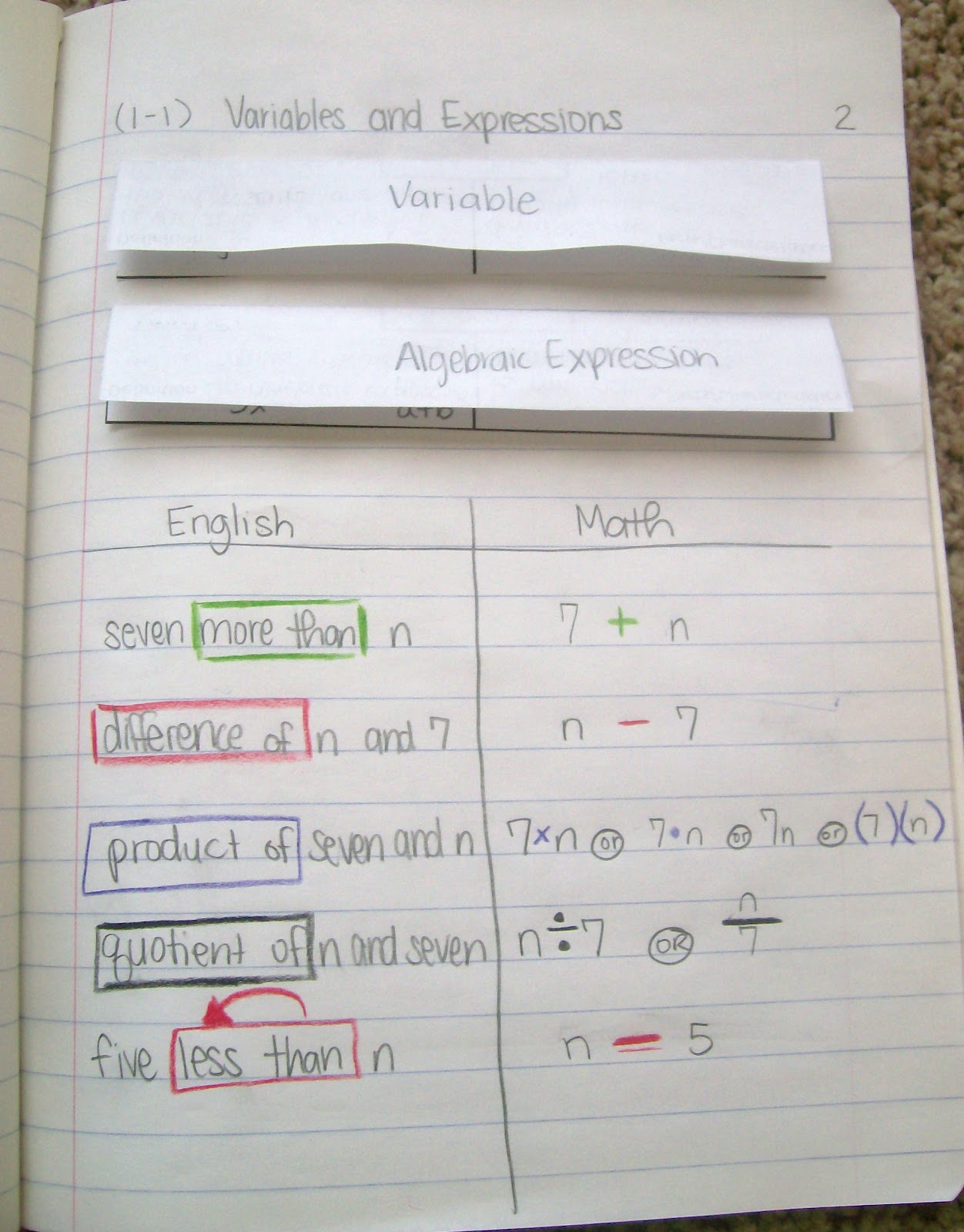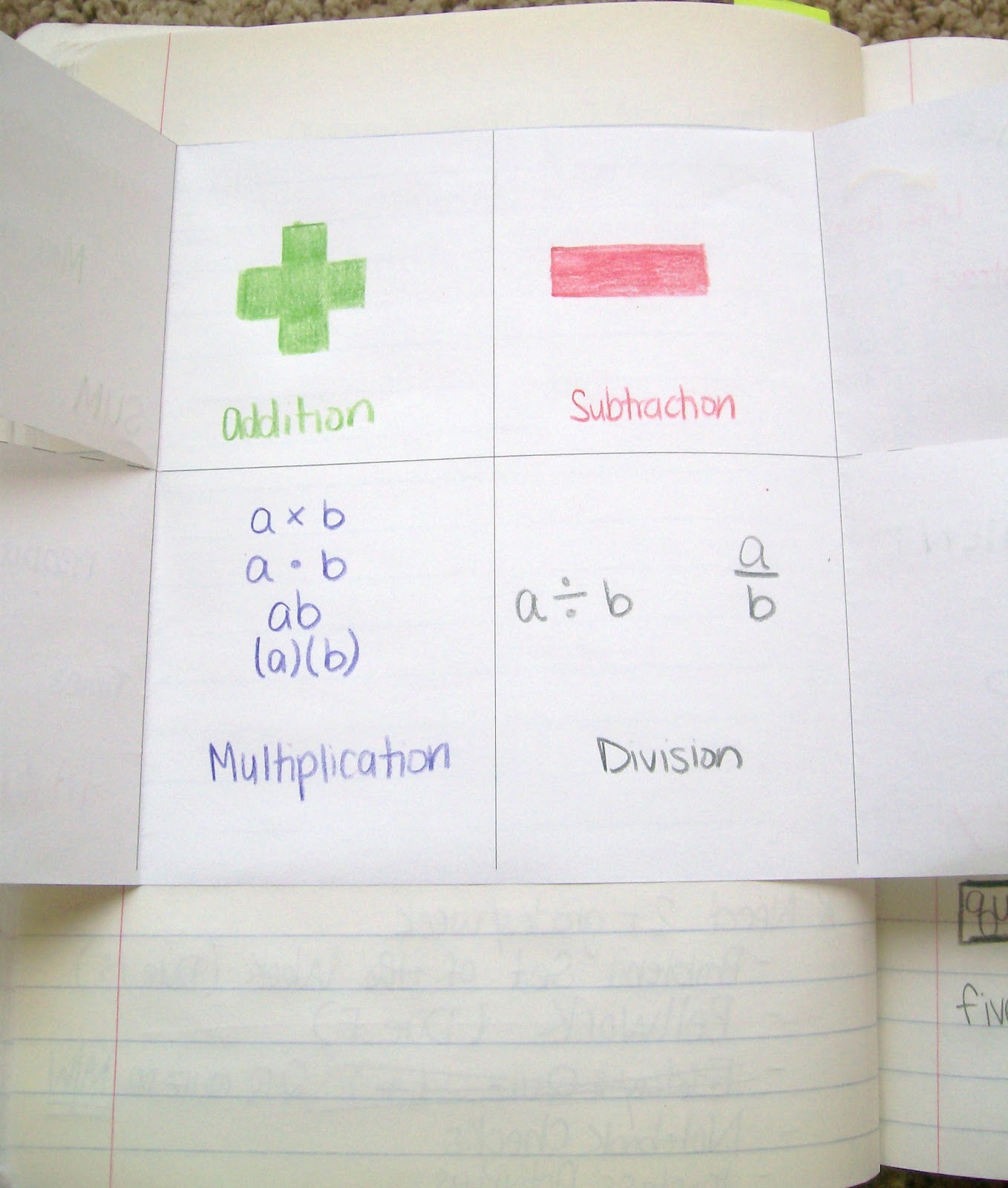Translating Expressions Foldable
Today I want to share a translating expressions foldable I designed for my Algebra 1 students to complete in their interactive notebooks. I will be teaching 3 sections of Algebra 2, 2 sections of Algebra 1, and 1 section of Math Analysis (College Algebra) this year. It’s a good thing I love algebra since I will be teaching it all day every day!
Translating Expressions Foldable
This will be our first INB entry in Algebra 1. I am starting the year with translating expressions.

The idea of Turn Around Words (“Less Than”) was totally borrowed from Julie Reulbach and her wonderful I Speak Math blog.
Check out these mini frayer models. They print 6 to a page. I have shared a file below.

And credit for the idea folding the Frayer Model in half to glue into the INB, goes to Katie @ Middle School Math Madness. I love her blog!

This four door foldable for translating expressions is one of my favorite foldables.


I started drawing the symbols. But, then I also wanted to show my students the different ways to represent multiplication and division.


Changes to Make
Oh, and here is what I want to change. When I was making my foldable, I got out my colored pencils, and I wanted to use them to make my foldable pretty and colorful. But, after I finished, my mind kept going back to a tweet I had read about a week ago. @mgolding who blogs here (and is the one who originally inspired me to try interactive notebooks!) tweeted the following:
@jreulbach Color With a Purpose strikes me as hard to do right. I like”underline unit vocab with yellow” as one CWP.
— Megan Hayes-Golding (@mgolding) July 27, 2012
CWP. Color With a Purpose. Did my pretty colors really serve a purpose on the foldable other than to make it pretty? No. So, how can I use colors to help my students grasp the lesson better? Next, I made the English/Math table on the RHS. Next, I started thinking about what if I gave each of the four operations (add, subtract, multiply, divide) their own color. Since I couldn’t undo my rainbow of colors on the outside of my sample foldable, I used the colors of the operations on the inside of the foldable.
With each English phrase, I circled / boxed / marked each key word with the color of the operation it corresponded to. So, when I make my final draft, all my addition words will be one color. All my subtraction words will be another color, etc. Then, I also wrote the operation in that same color on the Math side of the table.
This foldable would make a great reference when working through activities like my Translating Algebra Around the Room Activity.
Files
Frayer Models – 6 to a Page
My version of the Frayer Model. I got 6 to fit to a page. I resized them so they were only 1 inch tall when folded and placed in my interactive notebook.
Click here to SAVE the file to your device.
Frayer Model 6 to a Page (PDF)
7247 saves – 15.18 KB
Blank 4 Door Shutter Foldable
I originally made my four door shutter foldable with a full sized piece of paper, but I thought it was a little big for my composition notebook. So, I downsized it a bit, and I’m much happier with it now.
Click here to SAVE the file to your device.
4 Door Blank Shutter Foldable (PDF)
11689 saves – 1.43 KB







It's so hard to find math teachers who use interactive notebooks! I love using the notebooks… they have such impact. I am so happy Pinerest brought me to your blog. I must say, my algebra pages were the saddest, (I teach 5th/6th grade math) and you've given me some awesome ideas. Thank you! My tip to share- include the word, "OF" when teaching multiplication… made a world of difference- especially when working with decimals or fractions. 3/4 OF x for example…
I give a lot of notes in my 6th grade math class and try always to add parts that are more interactive. I love to play with windows and slides. Thank you for this. I will be using it.
I love the folded frayer models. This would be great for studying vocab too! Thank you for sharing your templates!!!
I agree with Kimberly… so thankful for Pinterest! I am doing math notebooks with foldables for the first time this year. I teach 5th grade, and we just started our chapter on variables, so this is so absolutely perfect for me! Thank you for the Frayer model download- I was going to tackle making my own tomorrow, but yours are perfect! Even down to what I need to write on the inside.
Great blog!!!
Lori
Wow, I am so glad I found your blog! My 8th grade class will be starting these this week. One question about the foldables and the Frayer's Models… Do you have them filled in already and then just show them to your class? Or do you wait for student input on examples, non-examples, etc.?
I love your INB! What did you put inside of your Evaluate an Expression frayer model. This was on the steps for evaluating expressions page.
Thanks so much for sharing your amazing ideas 🙂
Just nitpicking here, but aren't 1/2 and 15 examples of algebraic expressions?
You know, that's a really good question. My first instinct after reading this was "No, they are constants." But, the more I think about it, the more unsure I am. A quick google search showed some sites that say an algebraic expression must contain a variable and some sites that say an algebraic expression may contain a variable.
If it wasn't already past my bedtime, I think my next line of research would focus on numerical expressions vs algebraic expressions. Would 15 be a numerical expression? Can something be both a numerical expression and an algebraic expression?
But, what about the fact that I could rewrite 15 as 15x^0 + 0 ? That would include both a variable and an operation.
I'm afraid I have more questions than answers. I think it might be interesting to present this problem to my students.
Glencoe McGraw-Hill
An "algebraic expression" consists of sums and/or products of numbers and variables.
A "term" of an expression may be a number, a variable, or a product or quotient of numbers and variables.
So isn't the integer 15 simply a term (we call it a constant), as would be the real number 0.5?
But technically, since "1/2" is considered 1 divided by 2 — which throws it into the "expression" category (it's a quotient of two integers)?
You are unique and awesome in that you are so willing to share! I appreciate this site since I am not a math teacher by degree and need ideas to teach in the Adult Basic Ed program. Thank you so much.
You are very welcome! Thanks for reading my blog!
I love how you did this section! I'm a gr. 8 algebra 1 teacher at an international school in Taiwan and I've been looking for a way to make my math class more interesting. I'm planning on doing this with my algebra students in a couple of days 🙂 Thank you so much! Keep the examples of ISN coming!
I'm an "afterschooling" mom and I have to reteach what the teacher taught because my son comes on looking so confused! We are working on our INB today. Thanks for posting this! It helps me more than you can imagine!!!!
You are very welcome! I'm glad I could be of assistance!
Wow! I am so thankful to have stumbled upon your sight! Very creative with plenty of easy-to-understand explanations. Why couldn't my high school math teachers do this? It would have made a world of difference to me if I had these interactive notebooks to learn from.
Thanks for the sweet comment! I do believe that these notebooks have made a world of difference for my students!
One thing that started working for me is to distinguish "Turn Around Words" by the word than…It helps create the habit when they see more than, less than, greater than, etc. Therefore, while it doesn't change the end result in simple expressions, it does help with expressions with more than one operation that require grouping.
Great idea, Kim!
I'm not an INB teacher (yet!), but one thing I have tried to be more conscious of during the last two years is using color in my notes as much as possible IF it serves a purpose! I require my students to have highlighters for that reason. I try to approach it as color coding for easier reference. I feel that it makes their notes easier for them to interpret when they go back to them 5 hours or 5 days later, and let's face it, those are the times they need their notes, not when the material is fresh!
One of my favorite terms I learned when researching interactive notebooks was "color with a purpose." This sounds like exactly that!
I am the editor of the Kansas Association of Teachers of Mathematics Bulletin. Our October issue is focused on "Attend to precision", and I'd love to use the picture of your Frayer models in your ISNs. Would you mind if we used that picture? We will credit your blog. Thanks for letting me know!
Sure! Use anything you like!
You know what, you are an Angel sent from our heavenly father. I just completed my first year teaching and seeing this just brought so much joy. I wanted to come up with a creative way of structuring my classroom for next year and I know, in my heart, that this is it. Thank you for sharing. I particularly, love you Q&A portion of the site as you answered most of my questions. I know you have a life but your posts are amazing.
Thanks for your sweet comment!
Thank you just doesn't seem to be sufficient, but it's all the English language has to offer. I appreciate you sharing your awesomeness with us!!!!! So happy I found your blog. Thank you again!!!! You rock!
I've retired from public education and I am now working in a private school as a Pre-Algebra teacher. I have enjoyed reading your blog and seeing your ideas for ISNs. Your students are fortunate to be in your class.
Can you explain where your students keep their homework assignments? Are those practice problems included in their ISNs or are they in a separate notebook or binder?